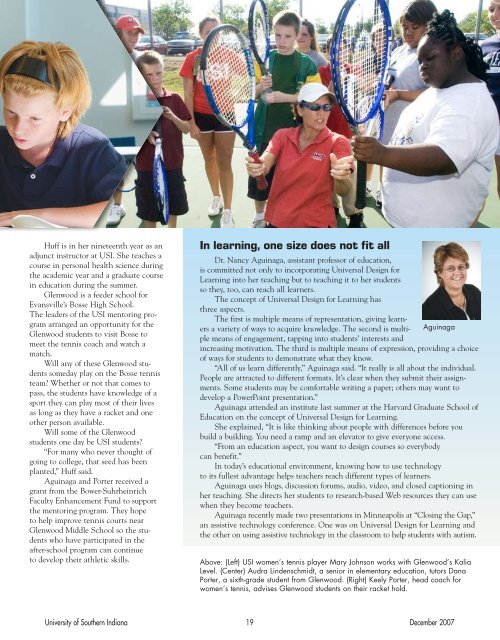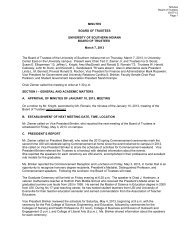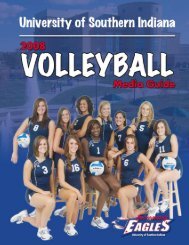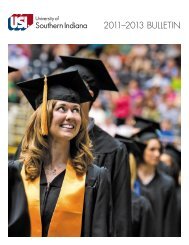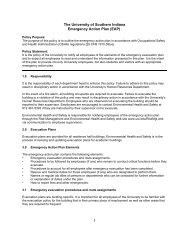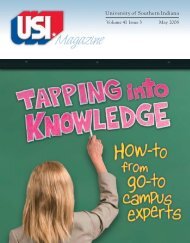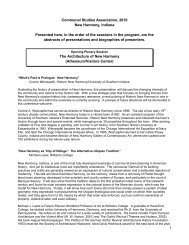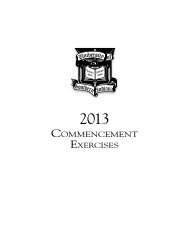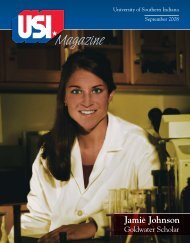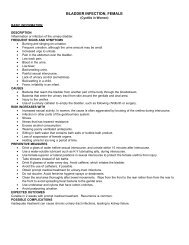2008 Winter - University Of Southern Indiana
2008 Winter - University Of Southern Indiana
2008 Winter - University Of Southern Indiana
- No tags were found...
Create successful ePaper yourself
Turn your PDF publications into a flip-book with our unique Google optimized e-Paper software.
Huff is in her nineteenth year as anadjunct instructor at USI. She teaches acourse in personal health science duringthe academic year and a graduate coursein education during the summer.Glenwood is a feeder school forEvansville’s Bosse High School.The leaders of the USI mentoring programarranged an opportunity for theGlenwood students to visit Bosse tomeet the tennis coach and watch amatch.Will any of these Glenwood studentssomeday play on the Bosse tennisteam? Whether or not that comes topass, the students have knowledge of asport they can play most of their livesas long as they have a racket and oneother person available.Will some of the Glenwoodstudents one day be USI students?“For many who never thought ofgoing to college, that seed has beenplanted,” Huff said.Aguinaga and Porter received agrant from the Bower-SuhrheinrichFaculty Enhancement Fund to supportthe mentoring program. They hopeto help improve tennis courts nearGlenwood Middle School so the studentswho have participated in theafter-school program can continueto develop their athletic skills.In learning, one size does not fit allDr. Nancy Aguinaga, assistant professor of education,is committed not only to incorporating Universal Design forLearning into her teaching but to teaching it to her studentsso they, too, can reach all learners.The concept of Universal Design for Learning hasthree aspects.The first is multiple means of representation, giving learnersa variety of ways to acquire knowledge. The second is multiplemeans of engagement, tapping into students’ interests andAguinagaincreasing motivation. The third is multiple means of expression, providing a choiceof ways for students to demonstrate what they know.“All of us learn differently,” Aguinaga said. “It really is all about the individual.People are attracted to different formats. It’s clear when they submit their assignments.Some students may be comfortable writing a paper; others may want todevelop a PowerPoint presentation.”Aguinaga attended an institute last summer at the Harvard Graduate School ofEducation on the concept of Universal Design for Learning.She explained, “It is like thinking about people with differences before youbuild a building. You need a ramp and an elevator to give everyone access.“From an education aspect, you want to design courses so everybodycan benefit.”In today’s educational environment, knowing how to use technologyto its fullest advantage helps teachers reach different types of learners.Aguinaga uses blogs, discussion forums, audio, video, and closed captioning inher teaching. She directs her students to research-based Web resources they can usewhen they become teachers.Aguinaga recently made two presentations in Minneapolis at “Closing the Gap,”an assistive technology conference. One was on Universal Design for Learning andthe other on using assistive technology in the classroom to help students with autism.Above: (Left) USI women’s tennis player Mary Johnson works with Glenwood’s KaliaLevel. (Center) Audra Lindenschmidt, a senior in elementary education, tutors DanaPorter, a sixth-grade student from Glenwood. (Right) Keely Porter, head coach forwomen’s tennis, advises Glenwood students on their racket hold.<strong>University</strong> of <strong>Southern</strong> <strong>Indiana</strong> 19 December 2007


